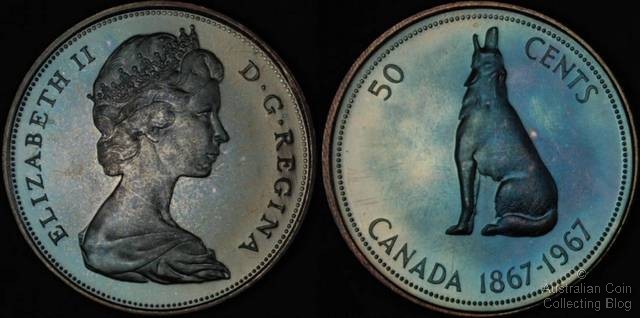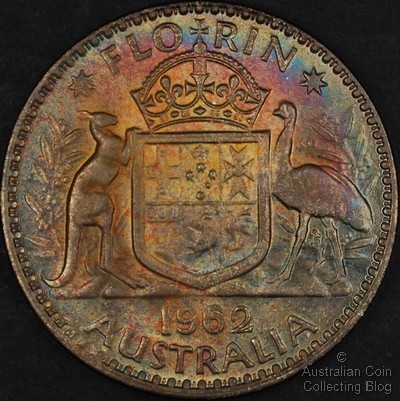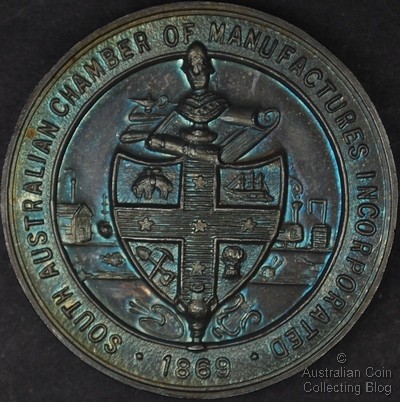May 2010 Archives
Whilst browsing internet auction catalogues, listed items, dealer stock or tables at coin shows I often come across some magnificently toned pieces which are very beautiful to look at. But should I be drawn to these coins?
When struck, silver coins should be bright with cartwheel lustre, copper should be red and lustrous. With the exception of some Perth copper coins struck on coloured planchets original coins shouldn't show colour or toning, this is all damage or effect that's occured over time.
The above statement is for a perfect coin, the one that would grade the highest but more often than not some issues were struck in conditions that were not ideal so finding the perfect coin is sometimes near impossible. Whether a problem with the die or the planchet the affect might be desireable or undesireable.
Some toning occurs with age and environmental factors, this is often unavoidable. The most obvious interesting toning occurs with incorrect storage. Sometimes this incorrect storage is the box of issue!! I'm talking here about the 1966 Australian Proof sets in the blue boxes. If these coins have been sitting there since issue then they most likely have been handled or succumbed to the perils of sitting in the felt lined box.
The Canadian 50c below is from a set that has been innocently sitting in it's box of issue since 1967. The box is felt lined, can you guess what colour the felt was?

Canadian 50c stored in original felt lined box
Coins like this sent to PCGS for grading may be turned away as genuine but non-gradeable due to questionable colour. This colour, although obtained innocently through it's own box of issue is not what we want to see on an original coin.
It's pretty and quite collectable in it's own right but not an original piece. It's possible to treat a coin with a chemical to obtain interesting colouring effects but again this might be desirable but isn't authentic.
The coin below was stored in a silk lined box lovingly created by it's owner for it's safe long term storage. Although I haven't showed you the obverse of the coin, it isn't toned at all, just the reverse in direct contact with the silk lining of the case. So, again we have a pretty coin, collectable in it's own right, but certainly not original and in reality to the serious collector, one that should be passed by.

1962 Florin stored in silk lined case
Another example below is a gorgeous example of a medal from 1947 that's been stored in a box full of cotton wool for 63 years. It's heavily toned with bright blue toning peeping through the devices.

1947 Medal stored in cotton wool.
Although all these coins above are quite pretty and collectable in their own right they've been damaged irreversible by poor storage choices. Some of these choices even being the original boxes of issue! It's important to keep this in mind when choosing a storage option for your coins that you aren't going to prematurely age your coin or damage it unintentionally.
 2010 20c - The Lost Soldiers of Fromelles
2010 20c - The Lost Soldiers of FromellesThe dramatic and tragic events of July 19th and 20th, 1915 on the Western Front in France around the small village of Fromelles have remained largely ignored in Australia until the last 10 years or so. One can only wonder how, in the late afternoon and evening of July 19th 1915 and the early hours of July 20th 1915 saw the single greatest loss of life in the Australian military in a single 24 hour period. During this period 5,533 Australians of the 5th AIF (Australian Imperial Forces) Division were killed, captured, or wounded along with 1,500 British of the supporting 61st Division. All of this happened in a largely pointless frontal attack by Australian and British forces against well entrenched German forces armed with modern machine guns and accurate and deadly artillery. Nearly 1300 of the Australian casualties remained 'known only to God', that is as un-identified bodies or missing entirely. To put the battle into perspective, more Australian soldiers were killed in 24 hours at Fromelles than in the Boer War, the Korean War, and the Vietnam War COMBINED. It truly was a tragic and awful 24 hours.
In 2002 a Greek born Australian, Lambis Englezos visited the existing Australian war cemetaries in the Fromelles area and upon seeing the 1299 names of those Australians who were named as missing in the Battle of Fromelles he became obsessed with the idea of finding out the fate of these valiant Australians. A long period of research and struggle ensued where Lambis and his supporters developed a theory that nearly 200 of the missing soldiers were in fact completely un-accounted for as the total number of unidentified Australian war graves in the area didn't account for all of the 1299 missing men. He theorised that the missing soldiers (and many of the missing British) had been buried in mass graves by the Germans around a small stand of trees next to the village of Fromelles and had remained un-discovered for nearly 100 years. Wanting an investigation into the site of the mass graves a long period of struggle with the Australian government and beauracracy ensued before finally in 2007 a non invasive survey of the area near the wood (known as Pheasant Wood) verified that mass graves with bodies in-situ were there. Exhumation of the graves commenced in 2009 and finally more than 250 bodies were recovered including 203 diggers. These bodies have been re-interred in new Australian war cemetary next to Fromelles and DNA samples have been taken in an effort to identify the dead. At the time of this entry a large number of the bodies have been positively identified based on comparison with DNA samples of descendants of those missing in the Battle. The sense of closure for surviving relatives is hard to imagine as a final resting place for uncles, fathers, great uncles and great grandfathers is finally known. If you want to learn more about the Battle of Fromelles take a look at the relating wikipedia entry.
In 2010 the Royal Australian Mint released the second "Australia Remembers" 20c coin (the first was the Australian War Nurses 20c) to remember the Lost Soldiers of Fromelles. A standard sized copper nickel 20c the obverse of the coin is the standard Ian Rank-Broadley portrait of Queen Elizabeth II. The reverse (by Vladimir Gottwald) shows the "Cobbers" memorial statue which is found in the V.C. Corner Memorial and Cemetery near Fromelles. This statue shows an Australian digger (SGT Simon Fraser) carrying a wounded mate (his 'cobber') back to Australian lines after the Battle of Fromelles. This scene was repeated many times in the days and nights after the Battle as diggers risked death to enter no-mans land to retrieve their wounded mates who lay all over the battlefield waiting for help. The coin was issued in a card showing the statue, remembrance poppies, and some information about the coin and battle.
On the 94th anniversary of the battle and the opening of the new Pleasant Wood Cemetary Australia Post also released this coin in a PNC.
If you take an interest in PNC's -Postal Numismatic Covers, then you'll know there are many many issues released jointly with Australia Past and The Royal Australian Mint and The Perth Mint. Some are released as a limited edition numbered item with a legal tender coin or a medallion.
With the release of a series of stamps by Australia Post also issued are a variety of stamp booklets, minisheets or first day covers marking the particular event or issue.
Where this goes awry is when non Australia Post people alter or add to genuine Australia Post articles for profit and the unsuspecting buyer can be sucked into thinking what they are buying is a genuine Australia Post release (We've spoken about this before).
This has shown itself on sites such as eBay when items are listed such as:
- Genuine First Day cover altered with a holed insert included with the envelope
- Genuine First Day Cover or PNC with overprinting, embossing or embellishment
- Genuine First Day Cover or PNC with extra postmarking
- Homemade stamp cover with non-original artwork replicating a genuine First Day Cover or PNC
- Homemade envelope with insert and legal tender coin or medallion with non-original artwork.
A good friend of the blog has recently corresponded with Australia Post to ask whether this altering is a breach of copyright. Here's what Australia Post had to say:
"Good afternoon, Mr XXXXXXXXX.I write in reply to your enquiry regarding the on selling of officially released Australia Post philatelic products.
I have viewed the item for sale through the eBay auction site and must advise, that unless the item is presented to the viewer as having been released by Australia Post in the manner to which it is presented, there is no action that we are able to take.
Buyers of philatelic covers, PNCs and miniature sheets are able to purchase these products, and then with suitable overprinting, use them to promote any number of events and celebrations. I believe this to be the case in the instance of the 200462727617.
However, there are copyright concerns within the product if permission was not obtained from the Australian Defence Force for the use of the word "ANZAC" and the application of the Rising Sun insignia which have both been applied to this particular product design.
Unfortunately, with a number of philatelic products sold through this particular site it remains a case of "Buyer Beware". I know this continues to be a source of frustration for collectors and I understand your disappointment when there is a feeling that an item is being sold well above the originally released price. I can only stress again that collectors need to be aware of officially released products. Being a recipient of the Australian Stamp Bulletin helps collectors keep up with official philatelic products from Australia Post.
There are also philatelic items that can be made up and sold by collectors. This is a common practice, as with commemorative covers, or overprinted objects for stamp shows and events.
A couple of instances where Australia Post copyright would be compromised is that if the designs on a product were used in another product and then on sold as their own, or if an amended official product was sold as being an officially released item without the express permission of the Australian Postal Corporation.
I hope this information has been of some assistance to you and I thank you for drawing the item to our attention.
Kind regards
Kerry D Tillison
Publications Consultant | Marketing
Philatelic Group | Australia Post"
In a nutshell this means that anyone can do anything to any Australia Post product and legally sell it as long as they don't claim it to be a genuine Australia Post issue. It really is a case of buyer beware. If you've seen something you'd like to buy on an auction site such as eBay, before you set that bid in place or click on that Buy It Now then do your research. Check the Australia Post website or other informative websites such as our weblog or a coin/stamp forum or your local coin/stamp dealer. Make sure you're not the next sucker of these sellers traying to make a quick buck.
We were recently contacted by a puzzled reader who, upon checking his eBay purchases recently seems to have come across a The Last Anzacs one dollar with a B mintmark that is dated the year 2000 and not 1999.
We can see from the 1999 and 2000 issues and mintages table that the mintmark dollar release for 1999 was The Last Anzacs one dollar. Mintmark coins for Brisbane, Melbourne, Adelaide and Sydney were produced at the Royal Australian Mint who also took their portable press to the show and visitors had the chance to strike the mintmark onto their own coin for $2.
The 1999 coin was also available to be struck with a C mintmark on the gallery press at the RAM and also released without a mintmark in a dual set with a Year of Older Persons one dollar.
In 2000, the same coin without a mintmark but with the date 2000 on the obverse was released in the form of a PNC. One thing to note if you are looking at Greg McDonald's Australian Coins and Banknotes catalogue is that there is a publication error and it incorrectly pictures a C mintmarked coin, this coin was issued without a mintmark.
So was a 2000 obverse coin struck with a mintmarked reverse?
How true is this story? I can only speculate as not having viewed this coin in person but it's quite possible that this has occured and this coin exists. Why not have a look at your mintmarked 1999 The Last Anzacs one dollar coins and see if there are any more of these accidental coins out there. We'd love to hear from you if you've found one!
 1999 Last Anzacs Dollar -now imagine a 2000 dated coin with a mintmark!
1999 Last Anzacs Dollar -now imagine a 2000 dated coin with a mintmark!

